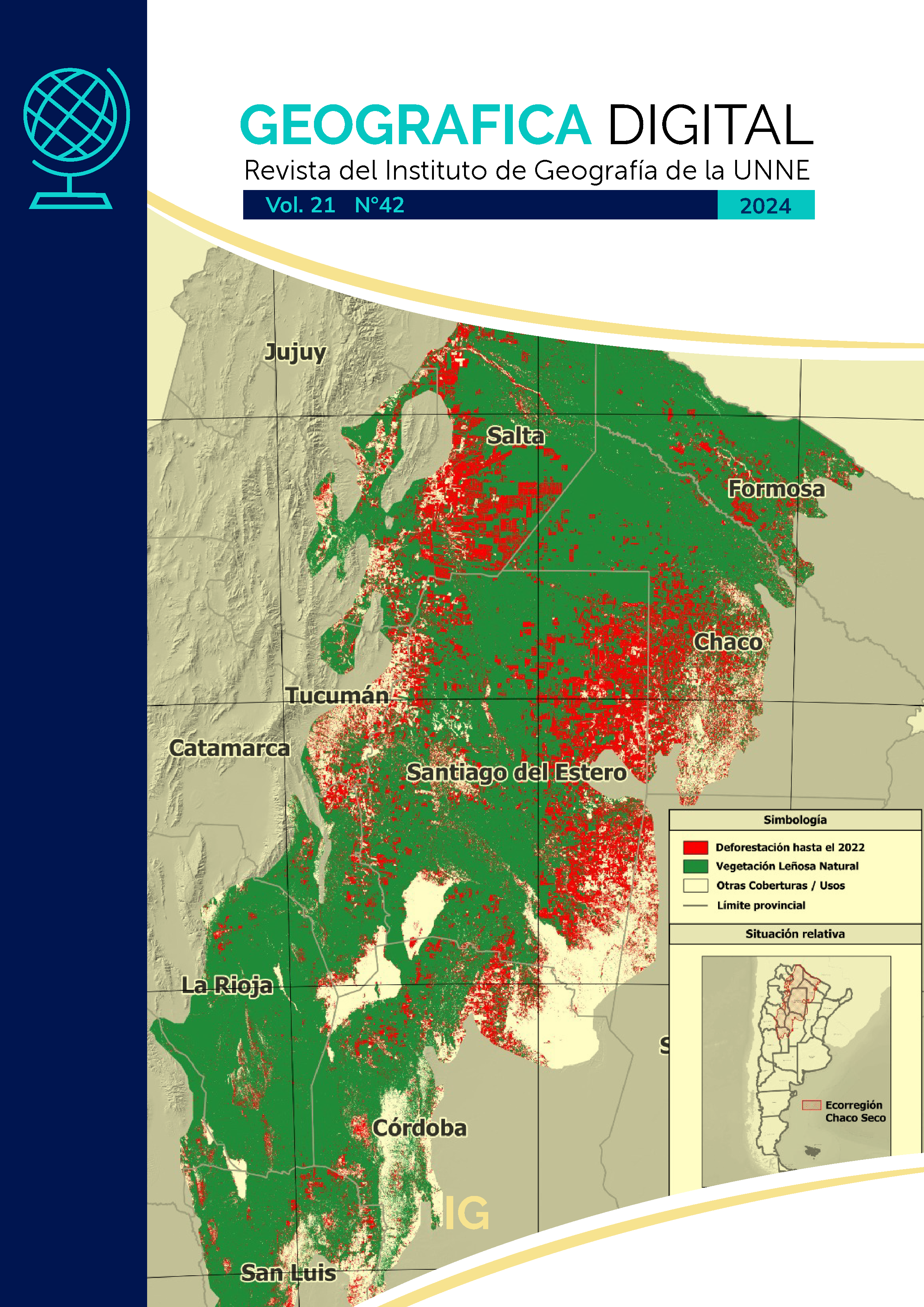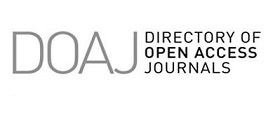Patrones de Precipitación asociados a Extremos de Caudal Medio Mensual en la Provincia de Corrientes (Argentina)
DOI:
https://doi.org/10.30972/geo.21427655Palabras clave:
Caudal, Estaciones de aforo, Río Paraná, ERA5, Excesos y déficitResumen
Se caracterizan los patrones de precipitación asociados a extremos de caudal medio mensual en los principales ríos de la Provincia de Corrientes, Argentina (1980-2022). Se utilizaron datos mensuales de caudal medio de seis estaciones de aforo para identificar casos donde el caudal medio fue inferior al percentil 5 (P05) o superior al percentil 95 (P95), definiendo los extremos mediante el criterio de ‘picos sobre un umbral’. Estos extremos se clasificaron según su alcance geográfico en localizados, intermedios y generalizados. Con la precipitación mensual del Reanálisis ERA5, se elaboraron campos de anomalías y se agruparon patrones similares mediante el algoritmo de k-means. Se detectaron cuatro patrones de precipitación para los extremos localizados, tres para los intermedios y dos para los generalizados. Los caudales inferiores al P05 se relacionan con anomalías pluviométricas negativas y los caudales superiores al P95 con anomalías positivas, aunque esta relación no es lineal debido a factores locales.
Citas
Abbas, O. A. (2008). Comparisons between data clustering algorithms. The International Arab Journal of Information Technology, 5(3), 320-325. https://iajit.org/portal/PDF/vol.5,no.3/15-191.pdf
Arshad, M., Ma, X., Yin, J., Ullah, W., Liu, M. y Ullah, I. (2021). Performance evaluation of ERA-5, JRA-55, MERRA-2, and CFS-2 reanalysis datasets, over diverse climate regions of Pakistan. Weather and Climate Extremes, 33(100373). https://doi.org/10.1016/j.wace.2021.100373 DOI: https://doi.org/10.1016/j.wace.2021.100373
Asadieh, B. y Krakauer, N. Y. (2017). Global change in streamflow extremes under climate change over the 21st century. Hydrology and Earth System Sciences, 21(11), 5863-5874. https://doi.org/10.5194/hess-21-5863-2017 DOI: https://doi.org/10.5194/hess-21-5863-2017
Ashraf, M. S., Ahmad, I., Khan, N. M., Zhang, F., Bilal, A. y Guo, J. (2021). Streamflow variations in monthly, seasonal, annual and extreme values using Mann-Kendall, Spearmen’s Rho and innovative trend analysis. Water Resources Management, 35, 243-261. https://doi.org/10.1007/s11269-020-02723-0 DOI: https://doi.org/10.1007/s11269-020-02723-0
Bačová-Mitková, V. y Onderka, M. (2010). Analysis of extreme hydrological events on the Danube using the peak over threshold method. Journal of Hydrology and Hydromechanics, 58(2), 88-101. https://doi.org/10.2478/v10098-010-0009-x DOI: https://doi.org/10.2478/v10098-010-0009-x
Baeza Sanz, D., Martínez-Capel, F. y García de Jalón Lastra, D. (2003). Variabilidad temporal de caudales: aplicación a la gestión de ríos regulados. Ingeniería del agua, 10(4), 469-478. https://doi.org/10.4995/ia.2003.2590 DOI: https://doi.org/10.4995/ia.2003.2590
Barros, V. y Camilloni, I. (2020). La Argentina y el cambio climático: de la física a la política. EUDEBA.
Bezak, N., Brilly, M. y Šraj, M. (2014). Comparison between the peaks-over-threshold method and the annual maximum method for flood frequency analysis. Hydrological Sciences Journal, 59(5), 959-977. https://doi.org/10.1080/02626667.2013.831174 DOI: https://doi.org/10.1080/02626667.2013.831174
Blanco, P. S. (2022). Estacionalidad del Río Paraná a la altura de Corrientes-Argentina durante eventos de bajantes históricas (1910-2021). Investigaciones y ensayos geográficos, (19), 13-30. http://hdl.handle.net/11336/214806
Bruniard, E. (1992). Hidrografía. Procesos y tipos de escurrimiento superficial. CEYNE.
Camilloni, I., Barro, V., Moreiras, S., Poveda, G. y Tomasella, J. (2020). Inundaciones y sequías. En: J. Moreno, C. Laguna-Defior, V. Barros, E. Calvo Buendía, J. Marengo, y U. Oswald Spring (Eds.), Adaptación frente a los riesgos del cambio climático en los países iberoamericanos (pp. 391-417). McGraw-Hill.
Capitanelli, R. (1992). Los ambientes naturales del territorio argentino. Un sistema basado en la diversidad. En J. A. Roccatagliata (Ed.), La Argentina: Geografía General y los marcos regionales (pp. 63-120). Planeta.
Carril, A., Cavalcanti, I., Menendez, C., Sörensson, A., López-Franca, N., Rivera, J., Robledo, F., Zaninelli, P., Ambrizzi, T., Penalba, O., da Rocha, R., Sanchez, E., Bettolli, M., Pessacg, N., Renom, M., Ruscica, R., Solman, S., Tencer, B., Grimm, A., ... Zamboni, L. (2016). Extreme events in the La Plata basin: a retrospective analysis of what we have learned during CLARIS-LPB project. Climate Research, 68(2-3), 95-116. http://dx.doi.org/10.3354/cr01374 DOI: https://doi.org/10.3354/cr01374
Carvalho, M. J., Melo-Gonçalves, P., Teixeira, J. C. y Rocha, A. (2016). Regionalization of Europe based on a k-means Cluster Analysis of the climate change of temperatures and precipitation. Physics and Chemistry of the Earth, 94, 22-28. https://doi.org/10.1016/j.pce.2016.05.001 DOI: https://doi.org/10.1016/j.pce.2016.05.001
Chauluka, F., Singh, S., y Kumar, R. (2021). Rainfall and streamflow trends of thuchila river, southern Malawi. Materials Today: Proceedings, 34, 846-855. https://doi.org/10.1016/j.matpr.2020.06.228 DOI: https://doi.org/10.1016/j.matpr.2020.06.228
Clarke, R. (2006). Análisis estadístico de eventos extremos en un contexto no estacionario. En: V. Barros, R. Clarke, y P. Silva Dias (Eds.), El cambio climático en la Cuenca del Plata (pp. 209-226). Centro de Investigaciones del Mar y la Atmósfera, CONICET.
Cui, M. (2020). Introduction to the k-means clustering algorithm based on the elbow method. Accounting, Auditing and Finance, 1(1), 5-8. https://www.clausiuspress.com/article/592.html
D’Silva, J. y Sharma, U. (2020). Unsupervised automatic text summarization of Konkani texts using K-means with Elbow method. International Journal of Engineering Research and Technolog, 13(9), 2380-2384. https://dx.doi.org/10.37624/IJERT/13.9.2020.2380-2384 DOI: https://doi.org/10.37624/IJERT/13.9.2020.2380-2384
da Silva, C. L. F., da Silva, D. D., Moreira, M. C., Rodrigues, J. M., de Sousa Rocha, I. S., Lima, R. P. C., y Calegario, A. T. (2023). Trend analysis and identification of possible periods of change in the occurrence of extreme streamflow events in a tropical basin. Journal of South American Earth Sciences, 128(104485). https://doi.org/10.1016/j.jsames.2023.104485 DOI: https://doi.org/10.1016/j.jsames.2023.104485
Deka, P. y Saha, U. (2023). Introduction of k-means clustering into random cascade model for disaggregation of rainfall from daily to 1-hour resolution with improved preservation of extreme rainfall. Journal of Hydrology, 620(129478). https://doi.org/10.1016/j.jhydrol.2023.129478 DOI: https://doi.org/10.1016/j.jhydrol.2023.129478
Dethier, E., Sartain, S., Renshaw, C. y Magilligan, F. (2020). Spatially coherent regional changes in seasonal extreme streamflow events in the United States and Canada since 1950. Science advances, 6(49). https://doi.org/10.1126/sciadv.aba5939 DOI: https://doi.org/10.1126/sciadv.aba5939
Díaz, E., García, M., Rodríguez, A., Dölling, O., Ochoa, S. y Bertoni, J. (2018). Temporal evolution of hydrological drought in Argentina and its relationship with macroclimatic indicators. Tecnología y ciencias del agua, 9(5), 1-32. https://revistatyca.org.mx/index.php/tyca/article/view/1973/1413
Fabre, M., Ojeda, A. y Tena, M. (2008). El río Guadalaviar: su comportamiento hidrológico. REHALDA, (7), 37-52. https://dialnet.unirioja.es/servlet/articulo?codigo=2602973
Far, S. S. y Wahab, A. K. A. (2016). Evaluation of peaks-over-threshold method. Ocean Science Discussions, 47, 1-25. https://doi.org/10.5194/os-2016-47 DOI: https://doi.org/10.5194/os-2016-47
Gao, L., Tao, B., Miao, Y., Zhang, L., Song, X., Ren, W., He, L. y Xu, X. (2019). A global data set for economic losses of extreme hydrological events during 1960‐2014. Water Resources Research, 55(6), 5165-5175. https://doi.org/10.1029/2019WR025135 DOI: https://doi.org/10.1029/2019WR025135
Guimberteau, M., Ronchail, J., Espinoza, J., Lengaigne, M., Sultan, B., Polcher, J., Drapeau, G., Guyot, J. L., Ducharne, A. y Ciais, P. (2013). Future changes in precipitation and impacts on extreme streamflow over Amazonian sub-basins. Environmental Research Letters, 8(1), 1-13. https://doi.org/10.1088/1748-9326/8/1/014035 DOI: https://doi.org/10.1088/1748-9326/8/1/014035
Gomes, M., de Albuquerque Cavalcanti, I. F., y Müller, G. V. (2021). 2019/2020 drought impacts on South America and atmospheric and oceanic influences. Weather and Climate Extremes, 34(100404). https://doi.org/10.1016/j.wace.2021.100404 DOI: https://doi.org/10.1016/j.wace.2021.100404
Gómez, C. (2020). Las represas internacionales y su influencia en la dinámica temporal del curso medio del Río Paraná. Párrafos Geográficos, 19(1), 89-99. https://www.revistas.unp.edu.ar/index.php/parrafosgeograficos/issue/view/54
Intergovernmental Panel on Climate Change [IPCC]. (2021). Summary for Policymakers. En: V. Masson-Delmotte, P. Zhai, A. Pirani, S. Connors, C. Péan, S. Berger, N. Caud, Y. Chen, L. Goldfarb, M. Gomis, M. Huang, K. Leitzell, E. Lonnoy, J. Matthews, T. Maycock, T. Waterfield, O. Yelekçi, R. Yu, and B. Zhou (Eds.), Climate Change 2021: The Physical Science Basis. Contribution of Working Group I to the Sixth Assessment Report of the Intergovernmental Panel on Climate Change (pp. 3-32). Cambridge, Reino Unido y New York, Estados Unidos: Cambridge University Press. https://doi.org/10.1017/9781009157896.001 DOI: https://doi.org/10.1017/9781009157896.001
Liu, M., Ma, X., Yin, Y., Zhang, Z., Yin, J., Ullah, I. y Arshad, M. (2021). Non‐stationary frequency analysis of extreme streamflow disturbance in a typical ecological function reserve of China under a changing climate. Ecohydrology, 14(7). https://doi.org/10.1002/eco.2323 DOI: https://doi.org/10.1002/eco.2323
Lozada, J., García, C., Herrero, H., Barchiesi, G., Romagnoli, M., Portapila, M., López, F., Castelló, E., Cossavella, A. y Brarda, J. P. (2015). Cuantificación del escurrimiento superficial de la cuenca del Río Carcarañá. Revista de la Facultad de Ciencias Exactas, Físicas y Naturales, 2(1), 59-72. https://revistas.unc.edu.ar/index.php/FCEFyN/article/view/9232
Mahto, S. S. y Mishra, V. (2019). Does ERA‐5 outperform other reanalysis products for hydrologic applications in India? Journal of Geophysical Research: Atmospheres, 124(16), 9423-9441. https://doi.org/10.1029/2019JD031155 DOI: https://doi.org/10.1029/2019JD031155
Marengo, J. A., Menéndez, A., Guetter, A., Hogue, T. y Mechoso, C. R. (2006). Eventos Hidrometeorológicos Extremos. Caracterización y Evaluación de Métodos de Predicción de Eventos Extremos de Clima y de la Hidrología en la Cuenca del Plata. Revista de Gestão de Água da América Latina, 3(2), 83-95. https://abrh.s3-sa-east-1.amazonaws.com/Sumarios/68/2fec10c7c34f3142d88dcb5f4a0e178d_4ff96015c3b2b75e379f7f904c05f159.pdf
Marianetti, G., Hinrichs, S. y Rivera, J. (2018). Cuando el río suena: análisis de los períodos de caudales extremos en los ríos de los Andes centrales de Argentina. Investigación, Ciencia y Universidad, 2(3), 195-197. https://ri.conicet.gov.ar/handle/11336/94881 DOI: https://doi.org/10.59872/icu.v2i3.175
Meis, M. y Llano, M. P. (2019). Hydrostatistical study of the Paraná and Uruguay Rivers. International Journal of River Basin Management, 17(1), 1-12. http://doi.org/10.1080/15715124.2018.1446962 DOI: https://doi.org/10.1080/15715124.2018.1446962
Meresa, H., Tischbein, B., Mendela, J., Demoz, R., Abreha, T., Weldemichael, M. y Ogbu, K. (2022). The role of input and hydrological parameters uncertainties in extreme hydrological simulations. Natural Resource Modeling, 35(1). https://doi.org/10.1111/nrm.12320 DOI: https://doi.org/10.1111/nrm.12320
Merz, B., Blöschl, G., Vorogushyn, S., Dottori, F., Aerts, J. C., Bates, P., Bertola, M., Kemter, M., Kreibich, H., Lall, U. y Macdonald, E. (2021). Causes, impacts and patterns of disastrous river floods. Nature Reviews Earth & Environment, 2(9), 592-609. https://doi.org/10.1038/s43017-021-00195-3 DOI: https://doi.org/10.1038/s43017-021-00195-3
Naumann, G., Podestá, G., Marengo, J., Luterbacher, J., Bavera, D., Arias Muñoz, C., Barbosa, P., Cammalleri, C., Chamorro, L., Cuartas, L., De Jager, A., Escobar, C., Hidalgo, C., Leal De Moraes, O., Mccormick, N., Maetens, W., Magni, D., Masante, D., Mazzeschi, M., ... Toreti, A. (2022). The 2019-2021 extreme drought episode in La Plata Basin. Publications Office of the European Union. https://doi.org/10.2760/773
Oliveira, D. H. M. C., Lima, K. C. y Spyrides, M. H. C. (2021). Rainfall and streamflow extreme events in the São Francisco hydrographic region. International Journal of Climatology, 41(2), 1279-1291. https://doi.org/10.1002/joc.6807 DOI: https://doi.org/10.1002/joc.6807
Permadi, V., Tahalea, S. y Agusdin, R. (2023). K-Means and Elbow Method for Cluster Analysis of Elementary School Data. Progres Pendidikan, 4(1), 50-57. https://doi.org/10.29303/prospek.v4i1.328 DOI: https://doi.org/10.29303/prospek.v4i1.328
Pike, M. y Lintner, B. R. (2020). Application of clustering algorithms to TRMM precipitation over the tropical and South Pacific Ocean. Journal of Climate, 33(13), 5767-5785. https://doi.org/10.1175/JCLI-D-19-0537.1 DOI: https://doi.org/10.1175/JCLI-D-19-0537.1
Pyszczek, O. L. (2016). Condiciones atmosféricas y clasificación climática del espacio geográfico correntino. En F. I. Contreras y M. P. Odriozola (Comps.), III Libro de la Junta de Geografía de la Provincia de Corrientes (pp. 6-17). Junta de Geografía de la Provincia de Corrientes.
Reshmidevi, T., Kumar, D., Mehrotra, R. y Sharma, A. (2018). Estimation of the climate change impact on a catchment water balance using an ensemble of GCMs. Journal of Hydrology, 556, 1192-1204. https://doi.org/10.1016/j.jhydrol.2017.02.016 DOI: https://doi.org/10.1016/j.jhydrol.2017.02.016
Rivera, J. y Penalba, O. (2018). Spatio-temporal assessment of streamflow droughts over Southern South America: 1961-2006. Theoretical and applied climatology, 133(3), 1021-1033. http://dx.doi.org/10.1007/s00704-017-2243-1 DOI: https://doi.org/10.1007/s00704-017-2243-1
Sistema Nacional de Información Hídrica [SNIH]. (2023). Sistema Nacional de Información Hídrica [Base de datos]. Secretaría de Infraestructura y Políticas Hídricas, Ministerio de Obras Públicas de la Nación. http://snih.hidricosargentina.gob.ar/
van Kempen, G., van der Wiel, K. y Melsen, L. (2021). The impact of hydrological model structure on the simulation of extreme runoff events. Natural Hazards and Earth System Sciences, 21(3), 961-976. https://doi.org/10.5194/nhess-21-961-2021 DOI: https://doi.org/10.5194/nhess-21-961-2021
Vincenti, R. D. (2004). La incidencia de los factores litológicos en el escurrimiento fluvial. Revista Geográfica, 63-78. https://www.jstor.org/stable/40996679
Vincenti, R. D. (2015). Simetrías y asimetrías en el escurrimiento fluvial superficial encauzado en las provincias de Chaco y Corrientes, según sus características fisiográficas. Investigaciones y ensayos geográficos, (12), 40-55. http://repositorio.unne.edu.ar/handle/123456789/51144
Vich, A., Norte, F. y Lauro, C. (2014). Análisis regional de frecuencias de caudales de ríos pertenecientes a cuencas con nacientes en la Cordillera de los Andes. Meteorológica, 39(1), 3-26. http://www.scielo.org.ar/scielo.php? script=sci_arttext&pid=S1850-468X2014000100001
Wang, W., Chen, X., Shi, P. y Van Gelder, P. (2008). Detecting changes in extreme precipitation and extreme streamflow in the Dongjiang River Basin in southern China. Hydrology and Earth System Sciences, 12(1), 207-221. https://doi.org/10.5194/hess-12-207-2008 DOI: https://doi.org/10.5194/hess-12-207-2008
Zhang, L., Liu, Y., Zhan, H., Jin, M. y Liang, X. (2021). Influence of solar activity and EI Niño-Southern Oscillation on precipitation extremes, streamflow variability and flooding events in an arid-semiarid region of China. Journal of Hydrology, 601, 126630. https://doi.org/10.1016/j.jhydrol.2021.126630 DOI: https://doi.org/10.1016/j.jhydrol.2021.126630
Zucarelli, G. (2013). Identificación de eventos hídricos extremos en la cuenca del río Paraná. Tecnología y ciencias del agua, 4(5), 181-187. https://www.scielo.org.mx/scielo.php? script=sci_arttext&pid=S2007-24222013000500012
Publicado
Cómo citar
Número
Sección
Licencia
Derechos de autor 2024 Geográfica digital

Esta obra está bajo una licencia internacional Creative Commons Atribución-NoComercial 4.0.


















